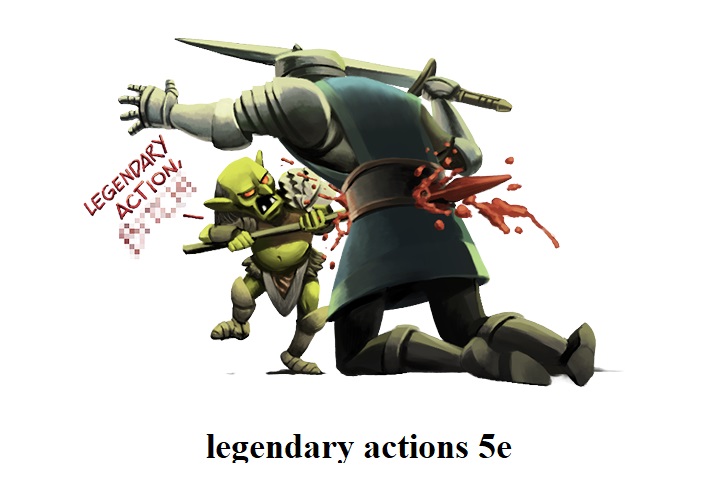Legendary Actions 5e – Dungeon and Dragons (D&D) Guide – 2023
What makes a legendary creature unique from the ordinary ones? They can use legendary actions 5e outside of their turn. You can feel it’s impact miles away. However, if a character becomes a legendary creature via a spell, it doesn’t mean that they acquire the legendary, lair or regional actions with it as well.
Table of Contents
More about 5e legendary actions
The primary thing to remember is that you can use legendary actions only after the end of your opponent’s turn. After the end of their turn, you can regain your actions to use them again. In simple terms, you can employ one legendary move per round. It’s your choice whether you prefer using the action or not. Furthermore, you can’t utilize them if you’re indisposed or if you can’t perform basic actions for some reason. These particular actions are the best tool to intimidate and threaten your enemy as it’d require them to look for unique ways to overcome its effects.
Mechanics of legendary actions 5e
According to Monster Manual, a creature owns 1-3 options regarding these special manoeuvres; however, there’s no restriction to the number of actions you choose from. These choices are unique, with different action costs and a fixed number of moves per round.
For instance, a character has the following 3 actions: Detect, Tail Attack, and Wing Attack. The first two cost 1 action while the third one costs 2 actions in every round. So if the player uses any of the first two options to strike their opponent, they’d still have 2 moves left for the subsequent chances. On the other hand, if they go for Wing Attack, they’d be left with only 1 move, later on, so they’d have to go for either Detect or Tail attack. In a way, one creature would have the power of multiple monsters inside it.
You can even homebrew creatures and actions, but keep in mind that they should have an upper limit to the extraordinary measures and cost more actions depending on their strength.

What are action cost tiers?
There are 3 levels of action cost that every player should know about.
- Tier 1 – One action cost leads to weak strikes and deviation. It includes manoeuvres such as weapon attack or dash action.
- Tier 2 – Now taking it up a notch, this level consists of some of the most unique and solid attacks and proficiencies, including CC features. All the hits that have an enormous impact or can CC the opponent, ranging from low to mid-level attacks, are a part of it.
- Tier 3 – You’d find unique, influential AoE spells and traits in this stage. It’d cause massive destruction, damaging CC, or a little of both.
List of legendary actions 5e
The list below consists of all the special manoeuvres in DnD; however, the effects mentioned here are general to aid the DM. A manoeuvre would take 1 action unless specified differently.
- Detect – This action is used by Aboleth (CR 10), Ancient and Adult Dragons (CR 14 and 20). For this, the player does a Wisdom (Perception) check in it.
- Claw attack – In this, the creatures Androsphinx (CR 17), Gynosphinx (CR 11) make one claw attack.
- Tentacle attack or fling – The Kraken (CR 23) use a tentacle or fling attack. The player would go for a large or small object, thrown in a random direction 60 ft away, and knocked prone. If a target hits a solid surface, they receive 3 (1d6) bludgeoning damage for every 10 feet it was thrown.
- Cantrip – Its effects manifest in Lich (CR 21) as they cast a cantrip.
- Blinding dust – This legendary action’s effects are indicated as Sand swirls and blinding dust that surrounds the player, and the opponent within 5 feet should either successfully strike a DC 16 Constitution saving throw or get blinded until their next turn. A Mummy Lord (CR 15) can use this bonus.
- Unarmed strike – If you possess the Vampire (CR 13) then they’d go for an unarmed hit with this manoeuvre.
- Shimmering shields (costs 2 actions) – In this, the Unicorn (CR 5) either cloaks itself with a shimmering, magical field or the opponent it sees within 60 feet of him. The enemy acquires a +2 AC bonus until its next turn.
Legendary Resistance 5e
The entire motive of an LR is to ensure that a failed saving throw doesn’t render a powerful player completely helpless. It’s only sensible for such a formidable creature to remain almost invincible in the face of such a situation.
The program allows you to hit a successful saving throw by choosing three times; thus, creating a balance in devastating spells mechanics. LR is the reason why confronting such a creature is a difficult task.
The right time to use LR
This option is provided to you whenever you fail a saving throw. The player can either let the failed saving throw remain or turn into a success. You’d need to strategize when to use LR for your benefit and catch your enemy by surprise.
Legendary Resistance was introduced as a feature solely to make combat with influential creatures tormenting.
How to integrate LR in the Narrative of Combat?
It might be pretty frustrating for the spell-casters to fail a spell, consequently making them feel useless. However, it can all change if you understand the art of working this failure into the combat narrative.
For instance, instead of saying, “The Lich fails the save, but uses a Legendary Resistance,”
You can go for “You notice the Lich’s form is shrinking; it seems that your polymorph spell is coming into effect! Its body starts twisting and shrinking, but then it ends. The Lich secures a fist and responds with a gravelly shout, undoing the transformation. It looks at you, eyes burning brightly, and he says with surprise in his voice, “Well, I guess I should take you more seriously; this is going to be fun.”
Furthermore, a player’s reaction to employ LR is dependent on their intelligence, pride, and various other factors that come into play. You can be sure, though, that they’d give some reaction. Here are a few responses you can expect from them –
- Pride – I used it just for the sake of showing you that you can’t hurt me *inner voice* oh no, oh no, oh no
- Surprise – This feature is a last resort for such a formidable monster because no one equals them in combat.
- Denial – This was a one-time thing; it won’t happen again.
- Anger – How can a lowly creature push me to use this extreme measure!
Alternatives of LR
Since some of the DMs are against legendary resistance in the game, they can opt for these substitutes instead.
- Advantage on saving throw – Those DMs who are alright with letting go of their control and trust the dice to decide for them can offer the legendary player benefit on every saving throw. Everything is based on luck, and the creature also retains resistance to spells.
- Protection from specific impacts – Although most of the characters have this ability inherently, some don’t, especially those who are homebrewed. As a result, you can keep your creatures safe from certain magic, for instance, being charmed.
- Luck points – It isn’t much different between LR and luck points; however, LP allows the player to reroll the dice instead of automatically succeeding. This loophole makes it better than LR for some DMs because there’s a limit to it, and everything is left on to chance.
Lair Actions 5e
This is where it gets exciting. Every legendary character has a lair or home, so if you come across an opponent at your place, you have the upper hand due to the special conditions called “lair actions.” Your lair’s inherent magic gives you unique powers because you know of every nook and cranny of your home, such as secret passages. At an initiative of order 20, the beast can use any of its lair options; however, they can only employ one lair action per round.
No bonuses are applicable as it rolls a 20 for the initiative by default. Therefore, if a character rolls higher than 20, they’ll go for the lair. Since lairs let go of all ties, any creature that moves an exact 20 goes for the lair action. Similar to legendary actions 5e, you can’t use lair manoeuvres if you’re indisposed or can’t perform any other tactic. Also, they can employ it only after their initial turn in combat.
Mechanics
The primary thing to remember is that the character has 2-4 lair action options to choose from. They can’t use the same tactic twice to keep the enemy on their toes and prevent the combat from turning monotonous.
Here is how to make your lair fool-proof and dangerous –
- Lair terrain – Set your lair in an exquisite terrain; for instance, icy caves, underground chambers, labyrinthine jungles, etc. Ensure that they are accessible via unique modes of transportation such as flying, deep-diving, or spelunking.
- Lair actions – The inherent magic in your home might have environmental effects such as water tides overtaking creatures, swarming clouds of insects, collapsing ceilings, etc. It might also have magical reactions like spreading darkness, banishing creatures to a dream plane, or self-healing.
- Regional effects – Quite often, the magic isn’t limited to the lair’s interior and can also affect the area surrounding the house. However, this happens only with powerful creatures who spend most of their years at home or those who magically change it. The magic is present in the form of fog cloaking the land within a few miles of the lair, curses surrounding the land, non-magical fires are unable to light, etc.
These effects would either end immediately after the opponent dies or gradually fade away after their death. It’s a way to add more intrigue and mystery to the game since their impacts are non-threatening. Therefore, you can choose all or none of these outcomes depending on your narrative.
Lair Actions and its impact
We’ll talk about some of the creatures and their power while dueling.
- The Aboleth (CR 10) channels its rage through the water in its lair. It can attack its prey in water within 90 feet of it. The target must either use a DC 14 Wisdom saving throw successfully or take 7 (2d6) psychic damage. It reside around the Subterranean lakes, rocky depths of the ocean, ancient fallen underwater city.
- If you have Brass Dragon (CR 1, 6, 13, 20), then during combat a gust of wind constantly surrounds the creature. The prey within 60 feet of it can go for a successful DC 15 Strength saving throw or be thrown 15 feet away and knocked prone. Only protected flames like lanterns have a 50% chance of extinguishing, unlike others with none. They live in Ruin, canyon, cave network with ceiling holes for sunlight.
- In the case of the Gold Dragon (CR 3, 10, 17, 24), since the creature can predict the future, it has an advantage over the attack rolls, ability checks and saving throws until the initiative count of 20 on the subsequent round. Their shelter is in Idyllic lakes, mist-shrouded islands, cave complexes behind waterfalls, ancient ruins out of the way.
- The Green Dragon (CR 2, 8, 15, 22) has magical fog clouds surround a target that the creature can see within a range of 120 feet. The prey should either use a DC 15 Wisdom saving throw successfully or give in to the creature’s charm until the next round’s initiative count 20. You can find them around Marshy woods, subarctic taia, cliff or hillside with a hidden entrance, cave mouths behind waterfalls, partially submerged caverns, entrance behind vegetation.
Regional effects
This aspect tells you the magical power the creature’s lair holds and what it can do. Here are a few examples –
- The Black Dragon (CR 2, 7, 14, 21), Aboleth (CR 10) live in subterranean lakes, rocky depths of the ocean, an ancient fallen underwater city. Swamp on the frayed edge of civilization, partially flooded dismal cave, cavern, ruin. Within a mile of their lair, water bodies are polluted, causing the enemies who drink it to vomit it out instantly.
- A Bronze Dragon’s (CR 2, 8, 15, 20) lair is covered with underwater plants under a 6-mile area of the lair acquire bright hues. They seek refuge either in Coastal cave or salvaged shipwreck.
- In the Red Dragon’s (CR 4, 10, 17, 24) case, the targets experience small earthquakes within 6 miles of the creature’s home. They are located around High mountains or hills in caverns under snow-capped peaks, deep within abandoned mines and dwarven strongholds, caves with volcanic activity.
- The White Dragon (CR 2, 6, 13, 20) living in the Icy caves, deep underground chambers far from the sun, high mountain vales accessible only by flying, caverns in cliff faces, labyrinth ice caves in glaciers have lair similar to the region. Its freezing precipitation covers a distance of 6 miles from the lair that might turn into a blizzard when the creature’s asleep.
Structure of lair actions
These manoeuvres serve the purpose of either fighting your enemy, slowing them down or CC them.
- Tier 1 – This first stage benefits to the character on all attack rolls, ability checks, and saving throws until their next turn.
- Tier 2 – Here, the tactic is an AOE wherein the creature can banish the opponent to another plane or realm.
Description of lairs
5e lair actions are unique to every creature because of the distinctness of their shelters altogether. Some of the examples are present below –
- Adult Black Dragon – Their residence is a dreary cave, grotto, or ruin that is somewhat flooded. There are pools for the dragon to rest and for its enemies to ferment. It’s entirely covered with acid-pitted bones and flies hovering on carcasses of fresh kills. Animals like Centipedes, scorpions, and snakes crawl the place of death and decay.
- Adult Blue Dragon – Their home’s location is in barren places as their specialty is to use their lightning breath and burrowing ability to carve out crystallized caverns and tunnels underneath the sand. Thunderstorms are a common occurrence around their lair wherein narrow tubes covered with glassy sand ventilates the den. The sinkholes are this dragon’s first defense. A Blue Dragon destroys its home if someone invades it, crushing them under it. They return afterward to collect their belongings and those of the attacker.
- Adult Green Dragon – This dragon lives in the woods, and its lair is easy to spot because dense fog smelling like the creature’s poisonous breath surrounds it. Moss-covered trees cover it, and the light is emerald green in color, wherein every sound is a whisper.
How to increase CR with Legendary Actions and Lair Effects?
To ascertain how these two actions would affect an encounter’s challenge rating, the DM should use the “Wizards of the Coast” Experience Point Value table.
A DM must focus on the number of actions a creature has per round (both Legendary and Lair actions), the average amount of damage they can cause per round, and the number of debuffs they’ll acquire, decreasing their average damage input in turn.
We’ll compare a few creatures with and without these actions and observe the changes in their CR.
Based on the lowest difficulty to hardest, the ranks are – Deva, Stone Golem, Aboleth, Young Gold Dragon. Also, when you include legendary and lair actions, attempt to keep them within this range.
House rules
In DnD, establishing a few house rules helps the DM in avoiding chaotic occurrences between the members. Here are a few examples of it –
- Minimize the ki cost of every Elemental Discipline by 2 (to a minimum of 1) after you expend extra ki to increase the spell’s level.
- When you reach level 3, you study the Elemental Attunement discipline, by default, and two more fields of your choice.
- At stages 6th, 11th and 17th, you learn two new disciplines. You can also replace that study after you rise to a new level with another whose level requirements you meet.
- You have options to choose 2 cantrips from acid splash, firebolt, mold earth, produce flame, a ray of frost, shocking grasp. As you move up a stage, you can replace a cantrip for another instead of replacing an elemental discipline with the other. Suppose you have access to additional resources like the Xanathar’s Guide to Everything or Elemental Evil Player’s Companion. In that case, you can select other cantrips such as acid, cold, fire, or lightning damage, or an elemental theme with your DMs permission.
Faq
Legendary Actions 5e and Lair Actions are bonus actions in a way that the creature is allowed to use in a round. They have the option of using 3 of them per round after the opponent’s turn ends.
A player can choose separate actions if they have legendary actions. Each of them costs different number of actions. You can use only one at a time and they can’t use it if they are incapacitated. Your actions would come back when your turn starts.
No, legendary actions don’t count reactions because they occur outside of the enemy’s turn and your one reaction per turn is safe even after you exhaust your actions. They’ll help you to surprise attack.
Yes, legendary actions are spells but it doesn’t do anything. The Archlich can use these actions to cast spells and if their action or bonus action or reaction time is going on, and you throw a spell as well, then your turn isn’t over.
Legendary actions are bonus actions that can be taken only outside the creature’s turn. You can use only one action per round and only after the opponent’s turn ends. As soon your turn begins, you regain the legendary actions.
Yes, players can get legendary actions as these aren’t different from the ones the creatures acquire. You choose one option, one action after the enemy’s turn. The quantity of actions they can use depends on their long rest or proficiency bonus.
Conclusion
This article can’t encompass the uniqueness and essentiality of legendary actions 5e. There’s more to it than meets the eye; however, we tried our best to provide every little detail you’d need on your gaming journey. Go, give it a try!







